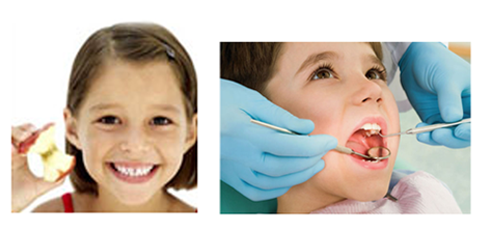" The man with a toothache thinks everyone happy whose teeth are sound. "
Pedodontics
Pit and Fissure Sealent for Pedriatic patients (childrens).
We are dedicated to "approach all dental problems of children with affection and tender care.
Ideally, your child's first dental visit should be before they have any dental problems. If you take your child to the dentist at an early age, your dentist can help you prevent any problems. We will check for decay and other problems, teach you how to clean your child's teeth daily and identify your child's fluoride needs. By starting dental visits early, you'll help your child build a lifetime of good dental habits.
Sealants help preventing tooth decay (dental caries), the most common dental disease among children. Your dentist can help prevent or reduce the incidence of decay by applying them to your child’s teeth.
A Sealant is a clear plastic material that, when applied to the chewing surface of a tooth, bonds into the grooves of the tooth to act as a barrier protecting the enamel from plaque and acids. It is applied to the back teeth (premolars and molars) where decay occurs most often. Sealant is most effective for children age 6 and older
Space Maintainer :
A Space maintainer is an appliance used to maintain the space of a prematurely lost Milk tooth until the eruption of the permanent Tooth. This will prevent later space problems and reduces the possibility of the need for orthodontic treatment.
Primary teeth:
Primary teeth are also called baby teeth, milk teeth, or first teeth. Baby teeth are very important as place holds for permanent teeth.
There a couple of simple rules that usually applies to the eruption of baby teeth:
->Lower teeth usually erupt before upper teeth
->Girls teeth usually erupt before boys teeth of the same age
->Teeth usually erupt in pairs
Your child's first baby tooth is another milestone in the growth of a child. Parents love to celebrate the tiny, yet momentous steps that pave a child's healthy development. Keeping your child free of tooth decay is the goal. A little effort may reveal the secrets how dentists keep their own children cavity free. Pedodontics focuses heavily on preventative oral care to reduce the risk of future complications like thumb sucking in the children, thus possibly reducing the risk of overbite. A Pedodontist may also start interceptive orthodontic treatment to prepare a child's mouth for future orthodontic work. By the child is nearly 18 months old, start keeping him from bottles by this age. Doing so will help prevent Baby Bottle Tooth Decay. By the time children are three years old, they usually have a full set of 20 primary teeth. Faulty brushing habits coupled with the consumption of sticky substances are generally responsible for triggering dental decay or dental caries in milk teeth.
Permanent teeth:
Usually start to erupt about first grade. A special note here is that often the first molar, or six-year molar, erupts before the front tooth. Additionally, the first molar erupts behind the last baby tooth and does not replace a baby tooth as occurs for front teeth. Often lower front teeth come in behind, on the tongue side, and give the appearance for a while as if there are two rows of teeth. If baby teeth are lost too early, the other teeth can drift out of their position and invade the empty space. This might cause permanent teeth to come in crooked or unable to erupt into the gum, which leads to malocclusion.
Dental care - common conditions - 0 to 5 years:
Mouth ulcers affect 20 per cent of the population. The natural healing takes one or two weeks. In the event these are painful and accompanied by fever, consult the dentist/doctor. Meanwhile, citrus in all forms should be avoided; take less salty foods; and apply topical anesthetic.







